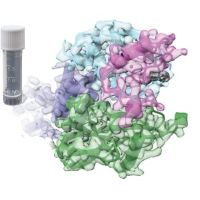Specification
| Description | Recombinant protein from the full-length sequence of Homo sapiens INSM transcriptional repressor 1 (INSM1) (NM_002196). |
| Organism | Homo sapiens (Human) |
| Expression Host | Human Cells |
| Tag Info | His or DYKDDDDK. Please contact us if you need further information or require specific designed tag. |
| Purity | Greater than 90% by SDS-PAGE gel |
| Uniprot ID | Q01101 |
| Entry Name | INSM1_HUMAN |
| Gene Names | INSM1 IA1 |
| Alternative Gene Names | IA1 |
| Alternative Protein Names | Insulinoma-associated protein 1 (Zinc finger protein IA-1) |
| Application | Antigens, Western, ELISA and other in vitro binding or in vivo functional assays, and protein-protein interaction studies; For research & development use only! |
| Buffer | Purified protein formulated in a sterile solution of PBS buffer, pH7.2, without any preservatives |
| Endotoxin | Endotoxin level is < 0.1 ng/µg of protein (<1EU /µg) |
| Length | 510 |
| Molecular Weight(Da) | 52923 |
| Protein Sequence | (The sequence of expressed protein may have some variation from the sequence shown below. Please contact us for the exact sequence.) MPRGFLVKRSKKSTPVSYRVRGGEDGDRALLLSPSCGGARAEPPAPSPVPGPLPPPPPAERAHAALAAALACAPGPQPPPQGPRAAHFGNPEAAHPAPLYSPTRPVSREHEKHKYFERSFNLGSPVSAESFPTPAALLGGGGGGGASGAGGGGTCGGDPLLFAPAELKMGTAFSAGAEAARGPGPGPPLPPAAALRPPGKRPPPPTAAEPPAKAVKAPGAKKPKAIRKLHFEDEVTTSPVLGLKIKEGPVEAPRGRAGGAARPLGEFICQLCKEEYADPFALAQHKCSRIVRVEYRCPECAKVFSCPANLASHRRWHKPRPAPAAARAPEPEAAARAEAREAPGGGSDRDTPSPGGVSESGSEDGLYECHHCAKKFRRQAYLRKHLLAHHQALQAKGAPLAPPAEDLLALYPGPDEKAPQEAAGDGEGAGVLGLSASAECHLCPVCGESFASKGAQERHLRLLHAAQVFPCKYCPATFYSSPGLTRHINKCHPSENRQVILLQVPVRPAC |
Background
| Function | FUNCTION: Sequence-specific DNA-binding transcriptional regulator that plays a key role in neurogenesis and neuroendocrine cell differentiation during embryonic and/or fetal development. Binds to the consensus sequence 5'-[TG][TC][TC][TT][GA]GGG[CG]A-3' in target promoters. Acts as a transcriptional repressor of NEUROD1 and INS expression via its interaction with cyclin CCND1 in a cell cycle-independent manner. Negatively regulates skeletal muscle-specific gene expression in endocrine cells of the pituitary by inhibiting the Notch signaling pathway. Represses target gene transcription by recruiting chromatin-modifying factors, such as HDAC1, HDAC2, HDAC3, KDM1A and RCOR1 histone deacetylases. Binds to its own promoter, suggesting autoregulation as a self-control feedback mechanism. Competes with histone H3 for the same binding site on the histone demethylase complex formed by KDM1A and RCOR1, and thereby inhibits demethylation of histone H3 at 'Lys-4' (PubMed:23721412). Promotes the generation and expansion of neuronal basal progenitor cells in the developing neocortex. Involved in the differentiation of endocrine cells of the developing anterior pituitary gland, of the pancreas and intestine, and of sympatho-adrenal cells in the peripheral nervous system. Promotes cell cycle signaling arrest and inhibition of cellular proliferation. {ECO:0000269|PubMed:11842116, ECO:0000269|PubMed:16511571, ECO:0000269|PubMed:16569215, ECO:0000269|PubMed:18417529, ECO:0000269|PubMed:19124461, ECO:0000269|PubMed:23721412}. |
| Pathway | |
| Protein Families | INSM1 family |
| Tissue Specificity | Expressed in pancreatic duct cells. Expressed in several tumor cell lines of neuroendocrine origin including pheochromocytoma, medullary thyroid carcinoma, insulinoma, medulloblastoma, retinoblastoma, pheochromacytoma, medullary thyroid carcinoma and small cell lung carcinoma. {ECO:0000269|PubMed:12890672, ECO:0000269|PubMed:1634555}. |
QC Data
| Note | Please contact us for QC Data |
| Product Image (Reference Only) |  |

